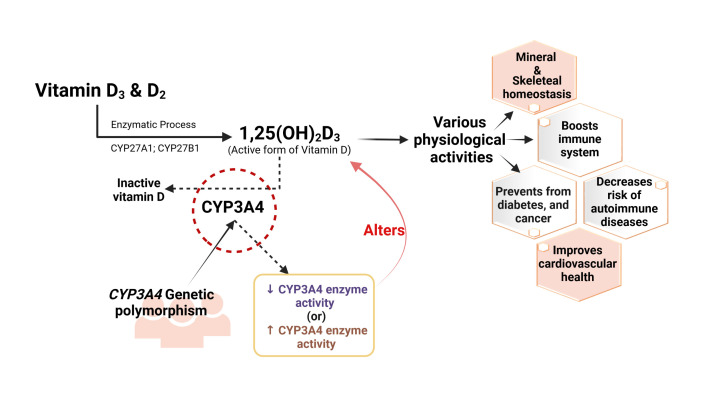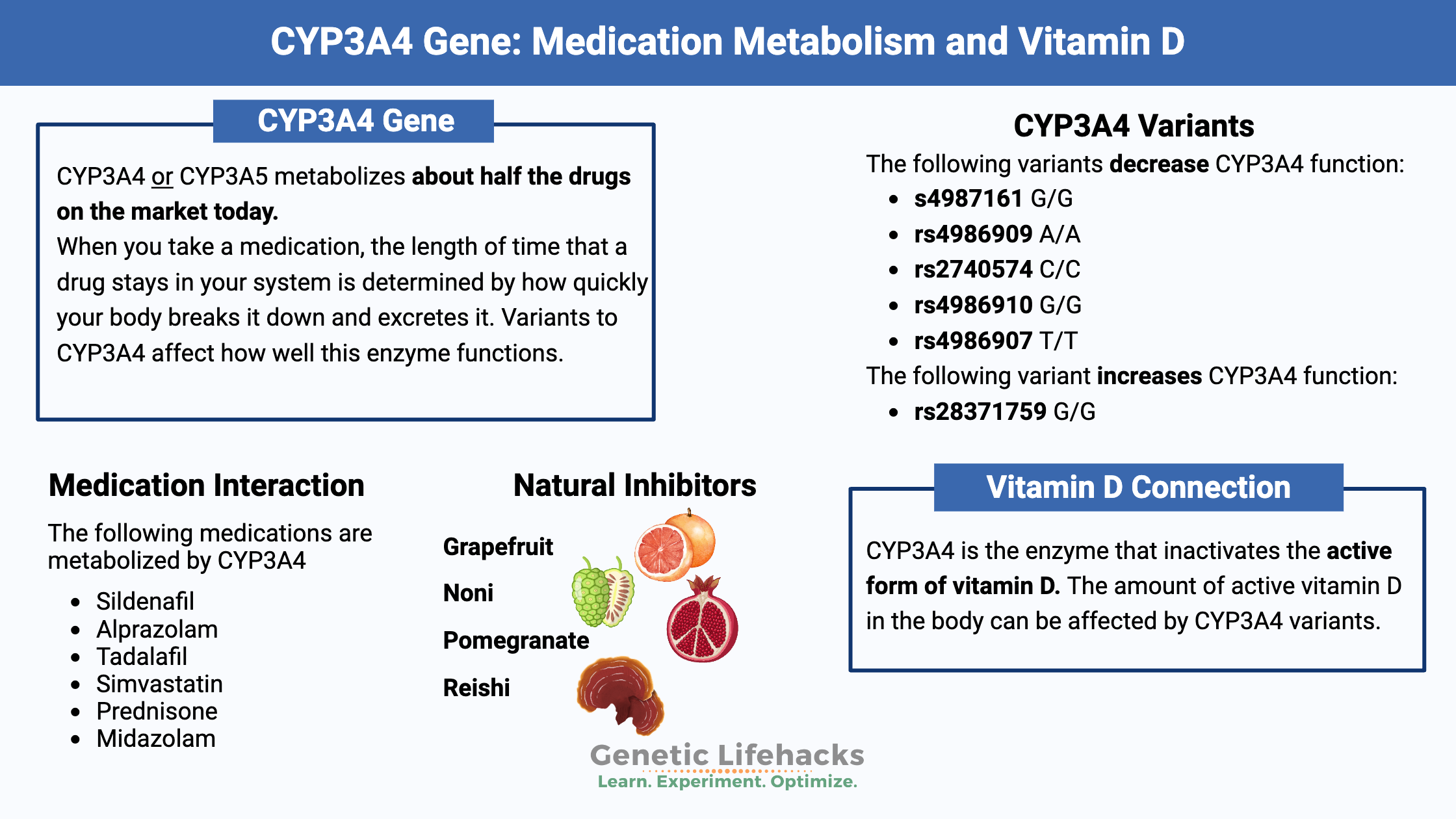Key Takeaways:
~ The CYP450 family of enzymes breaks down (metabolizes) toxins, medications, and vitamin D.
~ The CYP3A4 gene encodes the enzyme that metabolizes many commonly used drugs.
~ CYP3A4 genetic variants can impact whether someone clears a drug quickly or slowly, as well as how well a medication will work for an individual.
This article is part of a series of articles on phase I and phase II detoxification genes.
CYP3A4 and CYP3A5 enzymes and drug metabolism:
The CYP3A genes, which code for enzymes of the same name, are a subfamily of CYP 450. The CYP450 enzymes are used by the body to break down and eliminate many different toxicants and medications.
CYP3A4 or CYP3A5 metabolizes about half the drugs on the market today as well as other xenobiotics and steroids. When you take a medication, the length of time that a drug stays in your system is determined by how quickly your body breaks it down and excretes it.
There are genetic variants, or SNPs, in the CYP3A family that alter the function of the enzymes.
These variants impact how you react to a medication.
For example, if you don’t break down a medication as quickly, you may need less of the medication over time. Similarly, if you metabolize a medication more quickly than normal, you may need to alter the timing or change the dosage.
Common medications cleared by CYP3A4:
Here are a few of the more commonly prescribed drugs that are metabolized and thus cleared from the body using the CYP3A4 enzyme:
- sildenafil
- alprazolam
- tadalafil
- simvastatin
- prednisone
- midazolam
Methadone dosages can also be impacted by this gene.[ref]
A full list of drugs metabolized by CYP3A4 is available on Pharmacy Times and Wikipedia.
Natural inhibitors of CYP3A4:
CYP3A4 can be impacted by commonly taken supplements and fruit juice.
CYP3A4 and Grapefruit:
Several fruits – grapefruit, noni, pomegranate – are potent inhibitors of CYP3A4. This means that the fruit blocks (inhibits) the enzyme from working. Eating or drinking grapefruit, noni, or pomegranates can cause adverse effects on drug metabolism, either increasing the efficiency of the drug or decreasing the effect.
Commonly used as medicinal mushrooms, Reishi (Lingzhi) may inhibit CYP3A4 and may change medication clearance rates. The study was done in animals, but it is something to be aware of if you are taking reishi along with medications (especially if you are washing it all down with grapefruit juice).[ref]
Endogenous substances bioactivated by CYP3A4:
We don’t just have the CYP450 enzymes in the body to break down modern medications.
CYP3A4 is the enzyme that inactivates the active form of vitamin D (1,25(OH)2 D3). Thus, the amount of active vitamin D in the body can be affected by CYP3A4 variants that decrease the function of the enzyme. Some of the genetic variants that decrease CYP3A4 activity have been shown to increase 1,25(OH)2 D3 levels. Active vitamin D levels control calcium and bone density. CYP3A4 variants with increased enzyme activity are linked to an increased risk for low bone mineral density (BMD). [ref][ref]
Related article: Vitamin D – Genetic variants, receptor function

Testosterone metabolism also involves CYP3A4. CYP3A4 converts testosterone into three different hydroxylated metabolites: 6β-hydroxytestosterone (6β-OH-T), 2β-hydroxytestosterone (2β-OH-T), and 2α-hydroxytestosterone (2α-OH-T).[ref][ref]
Interestingly, the CYP3A4 enzyme is naturally more active in women than in men. This may cause differences in the way that women react to certain medications at higher doses.
Genotype Report:
CYP3A4 and CYP3A5
Lifehacks:
If you carry one or two copies of a CYP3A4 variant that is non-functioning, this may impact the way medications work for you. Look through the full list of drugs metabolized by this enzyme and talk with your doctor or pharmacist. (Keep in mind that 23andMe and AncestryDNA do not guarantee accuracy for medical purposes. Your doctor may want to run a second test to confirm.)
Grapefruit, noni, and pomegranate juices are inhibitors of CYP3A4 and CYP3A5. If you carry any of the genetic variants above for CYP3A4, be very careful of these juices or other inhibitors when taking a medication that is metabolized through CYP3A4.
St. John’s Wort is an inducer of CYP3A4, meaning it causes more of the enzyme to be created in the body. If you are taking a drug that is metabolized by CYP3A4, then you need to be careful with St. John’s wort interacting with the medication. (Talk with a doctor or pharmacist)[ref]
Related Articles and Topics:
Phase I and Phase II detoxification
Learn how the different genetic variants in phase I and phase II detoxification genes impact the way that you react to medications and break down different toxins.
Lithium Orotate + B12: The bee’s knees, for some people…
For some people, low-dose, supplemental lithium orotate is a game-changer when combined with vitamin B12. But other people may have little to no response. The difference may be in your genes.
Top 10 Genes to Check in Your Genetic Raw Data
Wondering what is actually important in your genetic data? These 10 genes have important variants with a big impact on health. Check your genes.
CYP2B6: Genetic variants impacting medication reactions
The CYP2B6 enzyme is part of the body’s first line of defense in detoxifying and breaking down certain and important for metabolizing several medications. Genetic variants of this enzyme either speed up or slow down its function.
References:
John R. Horn, PharmD, and PharmD Philip D. Hansten. “Get to Know an Enzyme: CYP3A4.” Pharmacy Times, vol. 0, Sept. 2008. www.pharmacytimes.com, https://www.pharmacytimes.com/view/2008-09-8687.
Klein, Kathrin, and Ulrich M. Zanger. “Pharmacogenomics of Cytochrome P450 3A4: Recent Progress Toward the ‘Missing Heritability’ Problem.” Frontiers in Genetics, vol. 4, Feb. 2013, p. 12. PubMed Central, https://doi.org/10.3389/fgene.2013.00012.
Lamba, Jatinder, et al. “PharmGKB Summary: Very Important Pharmacogene Information for CYP3A5.” Pharmacogenetics and Genomics, vol. 22, no. 7, July 2012, pp. 555–58. PubMed Central, https://doi.org/10.1097/FPC.0b013e328351d47f.
Lee, Su-Jun, and Joyce A. Goldstein. “Functionally Defective or Altered CYP3A4 and CYP3A5 Single Nucleotide Polymorphisms and Their Detection with Genotyping Tests.” Pharmacogenomics, vol. 6, no. 4, June 2005, pp. 357–71. PubMed, https://doi.org/10.1517/14622416.6.4.357.
Richards-Waugh, Lauren L., et al. “Fatal Methadone Toxicity: Potential Role of CYP3A4 Genetic Polymorphism.” Journal of Analytical Toxicology, vol. 38, no. 8, Oct. 2014, pp. 541–47. PubMed, https://doi.org/10.1093/jat/bku091.
Sprouse, Alyssa A., and Richard B. van Breemen. “Pharmacokinetic Interactions between Drugs and Botanical Dietary Supplements.” Drug Metabolism and Disposition, vol. 44, no. 2, Feb. 2016, pp. 162–71. PubMed Central, https://doi.org/10.1124/dmd.115.066902.

